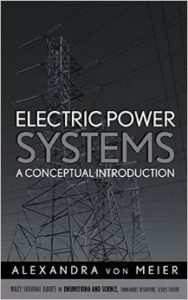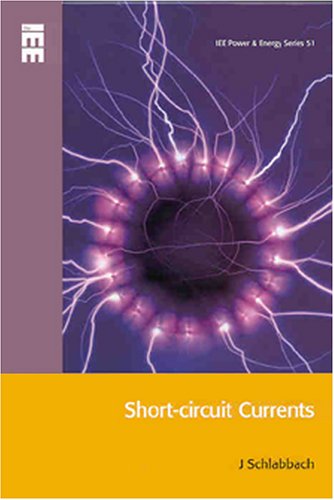| Book Name: | [PDF] Electric Power Systems : A Conceptual Introduction |
| Category: | Engineering Books |
| Free Download: | Available |
Electric Power Systems A Conceptual Introduction
Electric Power Systems by
Book Description:
A clear explanation of the technology for producing and delivering electricity
Electric Power Systems explains and illustrates how the electric grid works in a clear, straightforward style that makes highly technical material accessible. It begins with a thorough discussion of the underlying physical concepts of electricity, circuits, and complex power that serves as a foundation for more advanced material. Readers are then introduced to the main components of electric power systems, including generators, motors and other appliances, and transmission and distribution equipment such as power lines, transformers, and circuit breakers. The author explains how a whole power system is managed and coordinated, analyzed mathematically, and kept stable and reliable.
Recognizing the economic and environmental implications of electric energy production and public concern over disruptions of service, this book exposes the challenges of producing and delivering electricity to help inform public policy decisions. Its discussions of complex concepts such as reactive power balance, load flow, and stability analysis, for example, offer deep insight into the complexity of electric grid operation and demonstrate how and why physics constrains economics and politics.
Although this survival guide includes mathematical equations and formulas, it discusses their meaning in plain English and does not assume any prior familiarity with particular notations or technical jargon. Additional features include:
* A glossary of symbols, units, abbreviations, and acronyms
* Illustrations that help readers visualize processes and better understand complex concepts
* Detailed analysis of a case study, including a Web reference to the case, enabling readers to test the consequences of manipulating various parameters
With its clear discussion of how electric grids work, Electric Power Systems is appropriate for a broad readership of professionals, undergraduate and graduate students, government agency managers, environmental advocates, and consumers.
Buy PaperBook:Electric Power Systems: A Conceptual Introduction (Wiley Survival Guides in Engineering and Science)
Table Of Content:
1. The Physics of Electricity.
1.1 Basic Quantities.
1.1.1 Introduction.
1.1.2 Charge.
1.1.3 Potential or Voltage.
1.1.4 Ground.
1.1.5 Conductivity.
1.1.6 Current.
1.2 Ohm’s law.
1.2.1 Resistance.
1.2.2 Conductance.
1.2.3 Insulation.
1.3 Circuit Fundamentals.
1.3.1 Static Charge.
1.3.2 Electric Circuits.
1.3.3 Voltage Drop.
1.3.4 Electric Shock.
1.4 Resistive Heating.
1.4.1 Calculating Resistive Heating.
1.4.2 Transmission Voltage and Resistive Losses.
1.5 Electric and Magnetic Fields.
1.5.1 The Field as a Concept.
1.5.2 Electric Fields.
1.5.3 Magnetic Fields.
1.5.4 Electromagnetic Induction.
1.5.5 Electromagnetic Fields and Health Effects.
1.5.6 Electromagnetic Radiation.
2. Basic Circuit Analysis.
2.1 Modeling Circuits.
2.2 Series and Parallel Circuits.
2.2.1 Resistance in Series.
2.2.2 Resistance in Parallel.
2.2.3 Network Reduction.
2.2.4 Practical Aspects.
2.3 Kirchhoff’s Laws.
2.3.1 Kirchhoff’s Voltage Law.
2.3.2 Kirchhoff’s Current Law.
2.3.3 Application to Simple Circuits.
2.3.4 The Superposition Principle.
2.4 Magnetic Circuits.
3. AC Power.
3.1 Alternating Current and Voltage.
3.1.1 Historical Notes.
3.1.2 Mathematical Description.
3.1.3 The rms Value.
3.2 Reactance.
3.2.1 Inductance.
3.2.2 Capacitance.
3.2.3 Impedance.
3.2.4 Admittance.
3.3 Power.
3.3.1 Definition of Electric Power.
3.3.2 Complex Power.
3.3.3 The Significance of Reactive Power.
3.4 Phasor Notation.
3.4.1 Phasors as Graphics.
3.4.2 Phasors as Exponentials.
3.4.3 Operations with Phasors.
4. Generators.
4.1 The Simple Generator.
4.2 The Synchronous Generator.
4.2.1 Basic Components and Functioning.
4.2.2 Other Design Aspects.
4.3 Operational Control of Synchronous Generators.
4.3.1 Single Generator: Real Power.
4.3.2 Single Generator: Reactive Power.
4.3.3 Multiple Generators: Real Power.
4.3.4 Multiple Generators: Reactive Power.
4.4 Operating Limits.
4.5 The Induction Generator.
4.5.1 General Characteristics.
4.5.2 Electromagnetic Characteristics.
4.6 Inverters.
5. Loads.
5.1 Resistive Loads.
5.2 Motors.
5.3 Electronic Devices.
5.4 Load from the System Perspective.
5.4.1 Coincident and Noncoincident Demand.
5.4.2 Load Profiles and Load Duration Curve.
5.5 Single- and Multiphase Connections.
6. Transmission and Distribution.
6.1 System Structure.
6.1.1 Historical Notes.
6.1.2 Structural Features.
6.1.3 Sample Diagram.
6.1.4 Topology.
6.1.5 Loop Flow.
6.1.6 Stations and Substations.
6.1.7 Reconfiguring the System.
6.2 Three-Phase Transmission.
6.2.1 Rationale for Three Phases.
6.2.2 Balancing Loads.
6.2.3 Delta and Wye Connections.
6.2.4 Per-Phase Analysis.
6.2.5 Three-Phase Power.
6.2.6 D.C. Transmission.
6.3 Transformers.
6.3.1 General Properties.
6.3.2 Transformer Heating.
6.3.3 Delta and Wye Transformers.
6.4 Characteristics of Power Lines.
6.4.1 Conductors.
6.4.2 Towers, Insulators, and Other Components.
6.5 Loading.
6.5.1 Thermal Limits.
6.5.2 Stability Limit.
6.6 Voltage Control.
6.7 Protection.
6.7.1 Basics of Protection and Protective Devices.
6.7.2 Protection Coordination.
7. Power Flow Analysis.
7.1 Introduction.
7.2 The Power Flow Problem.
7.2.1 Network Representation.
7.2.2 Choice of Variables.
7.2.3 Types of Buses.
7.2.4 Variables for Balancing Real Power.
7.2.5 Variables for Balancing Reactive Power.
7.2.6 The Slack Bus.
7.2.7 Summary of Variables.
7.3 Example with Interpretation of Results.
7.3.1 Six-Bus Example.
7.3.2 Tweaking the Case.
7.3.3 Conceptualizing Power Flow.
7.4 Power Flow Equations and Solution Methods.
7.4.1 Derivation of Power Flow Equations.
7.4.2 Solution Methods.
7.4.3 Decoupled Power Flow.
7.5 Applications and Optimal Power Flow.
8. System Performance.
8.1 Reliability.
8.1.1 Measures of Reliability.
8.1.2 Valuation of Reliability.
8.2 Security.
8.3 Stability.
8.3.1 The Concept of Stability.
8.3.2 Steady-State Stability.
8.3.3 Dynamic Stability.
8.3.4 Voltage Stability.
8.4 Power Quality.
8.4.1 Voltage.
8.4.2 Frequency.
8.4.3 Waveform.
9. System Operation, Management, and New Technology.
9.1 Operation and Control on Different Time Scales.
9.1.1 The Scale of a Cycle.
9.1.2 The Scale of Real-Time Operation.
9.1.3 The Scale of Scheduling.
9.1.4 The Planning Scale.
9.2 New Technology.
9.2.1 Storage.
9.2.2 Distributed Generation.
9.2.3 Automation.
9.2.4 FACTS.
9.3 Human Factors.
9.3.1 Operators and Engineers.
9.3.2 Cognitive Representations of Power Systems.
9.3.3 Operational Criteria.
9.3.4 Implications for Technological Innovation.
9.4 Implications for Restructuring.
Appendix: Symbols, Units, Abbreviations, and Acronyms.
Index.
Description:
A clear explanation of the technology for producing and delivering electricity
Electric Power Systems explains and illustrates how the electric grid works in a clear, straightforward style that makes highly technical material accessible. It begins with a thorough discussion of the underlying physical concepts of electricity, circuits, and complex power that serves as a foundation for more advanced material. Readers are then introduced to the main components of electric power systems, including generators, motors and other appliances, and transmission and distribution equipment such as power lines, transformers, and circuit breakers. The author explains how a whole power system is managed and coordinated, analyzed mathematically, and kept stable and reliable.
Recognizing the economic and environmental implications of electric energy production and public concern over disruptions of service, this book exposes the challenges of producing and delivering electricity to help inform public policy decisions. Its discussions of complex concepts such as reactive power balance, load flow, and stability analysis, for example, offer deep insight into the complexity of electric grid operation and demonstrate how and why physics constrains economics and politics.
Although this survival guide includes mathematical equations and formulas, it discusses their meaning in plain English and does not assume any prior familiarity with particular notations or technical jargon. Additional features include:
* A glossary of symbols, units, abbreviations, and acronyms
* Illustrations that help readers visualize processes and better understand complex concepts
* Detailed analysis of a case study, including a Web reference to the case, enabling readers to test the consequences of manipulating various parameters
With its clear discussion of how electric grids work, Electric Power Systems is appropriate for a broad readership of professionals, undergraduate and graduate students, government agency managers, environmental advocates, and consumers.
Electric Power Systems. A Conceptual Introduction PDF
Author(s): Alexandra von Meier
Series: Wiley Survival Guides in Engineering and Science
Publisher: Wiley-IEEE Press, Year: 2006
ISBN: 0471178594,9780471178590,9780470036402
Related Results : best book for electrical power systems,best books electrical power systems,ebook of electrical power system,Electric Power Systems,electrical engineering power systems bookselectrical machines drives and power systems book,
Related More Books
See More POST On : Engineering Books









![[PDF] Draw Buildings and Cities in 15 Minutes Draw Buildings and Cities in 15 Minutes pdf](https://www.freepdfbook.com/wp-content/uploads/2021/06/Draw-Buildings-and-Cities-in-15-Minutes-218x150.jpg)








![[PDF] Digital Image Processing An Algorithmic Introduction Using Java Digital Image Processing An Algorithmic Introduction Using Java](https://www.freepdfbook.com/wp-content/uploads/2022/06/Digital-Image-Processing-An-Algorithmic-Introduction-Using-Java.jpg)




![[PDF] 43 Years JEE ADVANCED + JEE MAIN Chapterwise & Topicwise Solved Papers 43 Years JEE ADVANCED (1978-2020) + JEE MAIN Chapterwise & Topicwise Solved Papers Physics PDF](https://www.freepdfbook.com/wp-content/uploads/2022/03/43-Years-JEE-ADVANCED-1978-2020.jpg)

![[PDF] Problems in Physical Chemistry for JEE (Main & Advanced) Problems in Physical Chemistry for JEE (Main & Advanced) Free PDF Book Download](https://www.freepdfbook.com/wp-content/uploads/2022/03/Problems-in-Physical-Chemistry-for-JEE-Main-Advanced.jpg)
![[PDF] Engineering Physics (McGraw Hill)](https://www.freepdfbook.com/wp-content/uploads/2021/05/bafc8c2685bb6823a9c56134f7fba5df.jpeg)

![[PDF] Engineering Chemistry By Shashi Chawla](https://www.freepdfbook.com/wp-content/uploads/2022/05/Theory-And-Practicals-of-Engineering-Chemistry-By-Shashi-Chawla-free-pdf-book.jpeg)
![[PDF] Chemistry: An Introduction to Organic, Inorganic & Physical Chemistry Chemistry: An Introduction to Organic, Inorganic & Physical Chemistry](https://www.freepdfbook.com/wp-content/uploads/2022/04/Chemistry-An-Introduction-to-Organic-Inorganic-Physical-Chemistry.jpg)
![[PDF] Essentials of Physical Chemistry Essentials of Physical Chemistry Free PDF Book by Bahl](https://www.freepdfbook.com/wp-content/uploads/2022/04/Essentials-of-Physical-Chemistry-bahl.jpg)
![[PDF] Biological control of plant-parasitic nematodes: soil ecosystem management in sustainable agriculture Biological control of plant-parasitic nematodes: soil ecosystem management in sustainable agriculture](https://www.freepdfbook.com/wp-content/uploads/2022/05/Biological-control-of-plant-parasitic-nematodes-soil-ecosystem-management-in-sustainable-agriculture.jpg)
![[PDF] Human Anatomy: Color Atlas and Textbook Human Anatomy: Color Atlas and Textbook Free PDF Book](https://www.freepdfbook.com/wp-content/uploads/2022/05/Human-Anatomy-Color-Atlas-and-Textbook.jpg)
![[PDF] Concepts of Biology Book [Free Download]](https://www.freepdfbook.com/wp-content/uploads/2022/05/Concepts-of-Biology.jpg)
![[PDF] Essentials of Biology [Free Download] Essentials of Biology Free PDF BOok Download](https://www.freepdfbook.com/wp-content/uploads/2022/05/Essentials-of-Biology-Free-PDF-Book-Downlaod.jpg)
![[PDF] Human Biology Book [Free Download]](https://www.freepdfbook.com/wp-content/uploads/2022/05/PDF-Human-Biology-Book-Free-Download.jpg)



